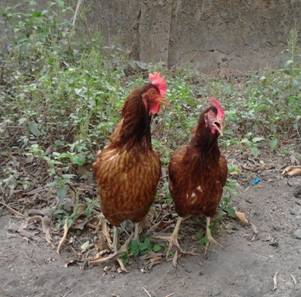
Animal: Gramapriya
Scientific name :
Common / Local Name :
The product particularly egg from native fowls is widely preferred specially because of the pigmentation, taste, flavour and suitability for special dishes. Only drawback of native fowl is lower egg production (40-60 per annum). The egg production can be improved by introduction of improved germplasms with better management. In this situation backyard poultry breed with an egg production capacity of 180-200 is suitable under the backyard condition in rural village. This production ensures the availability of eggs for the rural masses at cheaper rate which not only supplement the family nutrition and health but also provides supplementary income since egg is well balanced in all essential amino acids. Further there is a special demand for brown eggs which resembles the deshi hen eggs. The following technology adoption will meet the demand of farmers in rural areas to augment the income generation in addition to more employment opportunities.
Brooding is the care and management of new born chicks for successful rearing without hen. During initial stage of life, chicks cannot regulate their body temperature. they need artificial heat to maintain their body temperature. The young chicks need brooding up to 4 weeks of age. The brooding arrangement can be made either on floor or in cages as per the available facility. There should be adequate ventilation in brooder house to maintain balance of oxygen and carbon dioxide. Brooder house should be thoroughly cleaned and disinfected with a disinfectant solution (Phenol/Cresol) before arrival of chicks. All equipments like feeders, drinkers, hovers/brooding cages should be thoroughly cleaned before brooding is started. For floor brooding 2-3 inch thick layer of saw dust/rice husk/locally available litter material should be spread on the floor uniformly. Initially for 2-3 days news paper should be spread over the litter material to prevent chicks from eating litter till they learn eating feed because litter material may choke their throat causing death due to suffocation. Brooders should be warmed up 24 hours prior to the arrival of chicks. Optimum temperature of brooder house promotes good growth rate and reduces mortality in chicks. The starting temperature during brooding should be 95 0F in first week and should reduce 5 0F per week in successive weeks till 70 0F. Monitoring chicks behavior in brooder is important to note whether they are comfortable or not. If temperature is higher than the requirement, chicks will stay away from the heat source and if it is lower than the requirement they will come closer to the heat source. Chicks guard may be prepared from tin, hard card board or any other such locally available materials. Healthy and physically good chicks should be selected for brooding.

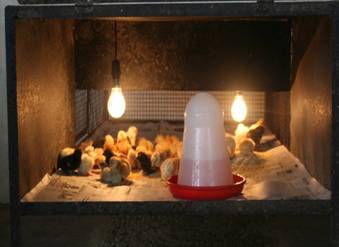
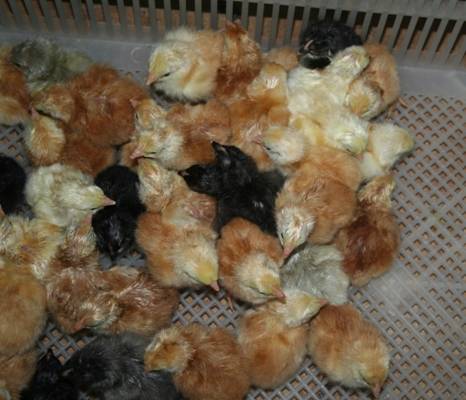
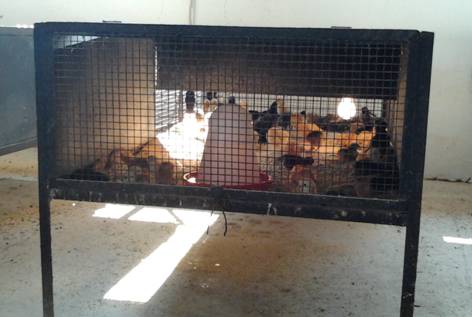
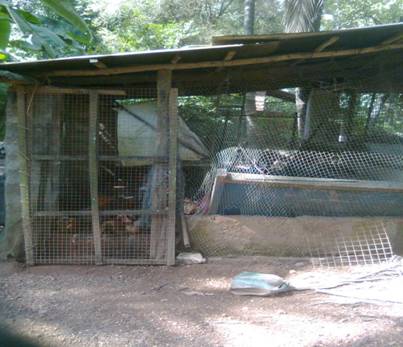
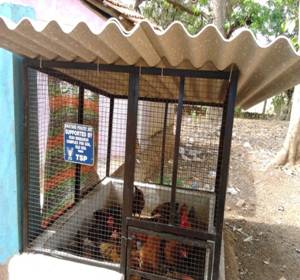

Housing is required for night shelter and protection from rain. This can be done by use of low cost material i.e. wire mesh or unused fishnet, bamboos and tarpaulin sheet. With the help of bamboo and wire mesh outside covering can be done and roofing can be done with tarpoline sheet. Coconut leaves can substitute tarpaulin/old asbestos sheet for roofing to reduce the cost of housing wherever available in plenty from own source. About 1.5-2.0 square feet floor space is required per bird.
Gramapriya chicks need balanced feed during initial 6 weeks of age under nursery rearing. As their nutrient requirements are low, alternate feed ingredients both for energy and protein can be incorporated in the diets without affecting their performance. In nurseries, chicks are reared on standard layer chick ration. For grower birds in second phase, besides the feed material available from free range, kitchen wastes and other kinds of grain or bran can also be provided as supplementary feed. Gramapriya can pick up its food easily from the backyard once it learns to scavenge. The need for additional supplementation depends on the free area available, intensity of vegetation, availability of waste grains, insects and grass seeds, etc. Male Gramapriya attain 1.2 kg at 12 weeks of age on broiler starter feed. Gramapriya pullets should be provided with supplemental calcium sources (i.e. lime stone powder, stone grit, marble chips or shell grit) mixed with feed or grain during lying phase @4-5 g/bird/day. This plan of feeding schedule has yielded successful results with high rate of survivability and good egg production. The eggs laid are tinted and have fairly good size. Balance ration for Gramapriya laying hens can be prepared as: Energy source-65-70 %, vegetable protein source-20-25 %, Animal protein source, 3-5 %, limestone-5-7 %, DCP-1-2 %, Common salt-0.5 %, Mineral mixture-0.5 % and Vitamin mixture-0.1 %. Energy sources include maize, bajra, ragi and wheat, Vegetable Protein sources are soybean meal, ground nut cake, sunflower oil cake, animal protein sources are fish meal, meat meal, silkworm pupae meal etc. Calcium and Phosphorous sources are shell grit, limestone, Di-calcium phosphate etc.
 Nursery Rearing
Nursery Rearing
 Male and Female
Male and Female
Suggested Practical Rations for Gramapriya chicks in nursery rearing:
Ingredients Diet using CAW Diet using rice kani Diet using brewers’ �?
dried grain
Ground maize 40.00 30.00 43.00
Cashew apple waste 10.00 - ?� �? -
Soybean meal 20.00 24.00 21.00
Fish meal 10.00 10.00 -
Broken rice - 20.00 -
Deoiled rice bran 19.00 15.00 13.00
Brewers?dried grain - - 20.00
Dicalcium phosphate 1.30 1.20 1.17
Lime stone 1.12 1.34 1.21
Common salt 0.40 0.50 0.50
Vitamin and
Average feed consumptions per bird per day
1st week -10 gm
2nd week -20gm
3rd week -30gm
4th week -40 gm
5th week -60 gm
Gramapriya chicks can be let free for scavenging in the backyard after 6 weeks. The male Gramapriya can be reared separately and marketed for meat purpose. The birds need to be habituated to return to the nest in the evening for night shelter. Night shelter should have good ventilation and should give protection from predators. Availability of plenty of clean and fresh water should be made throughout the life and birds must be vaccinated against Marek’s and Ranikhet diseases. Since birds are reared in the backyard they are more prone to parasitic infestation. Therefore, periodic deworming at 3-4 month intervals is essential. These birds can be reared under semi-intensive system by housing the bird in a litter floor house, and letting loose for free range scavenging in open backyard. The birds need to be vaccinated to prevent some commonly occurring diseases as per the vaccination schedule mentioned below.
Vaccination Schedule
Age, day Vaccine Dose Route
1 Marek’s disease 0.20 ml Subcutaneous
7 Ranikhet Disease (Lasota) one drop Eye
18 Ranikhet Disease (Lasota) one drop Oral
28 Ranikhet Disease (R2B) 0.50 ml Subcut/Intramuscular
Input availability |
Address/Contact details |
| Germplasm | Director, ICAR-CCARI, Old Goa-403 402, Goa Phone: (0832) 0832-2993097, E-mail: director.ccari@icar.gov.in |
|